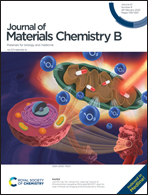Construction of GSH-triggered cationic fluoropolymers as two-in-one nanoplatforms for combined chemo-gene therapy†
Abstract
Combined chemo-gene therapy has become a promising approach for enhanced anti-cancer treatment efficacy. However, effective co-delivery of therapeutic genes and drugs into target cells and tissues remains a major challenge. In this work, a GSH-responsive cationic fluoropolymer PSSF was designed as a co-delivery platform and synthesized by introducing a perfluorinated chain into a low–molecular weight PEI-based cationic polymer through a disulfide bond. PSSF exhibits good ability for drug and gene loading, as well as fast drug release in a GSH-rich environment. Gene transfection assay revealed that PSSF could deliver both model genes and the p53 gene into tumor cells smoothly with good protein expression, while maintaining good biocompatibility. It was also demonstrated that PSSF could simultaneously deliver the p53 gene and DOX into the HeLa cells efficiently and realize fast release of DOX. In vitro and in vivo anti-tumor assays both demonstrated that the co-delivery system could inhibit tumor growth more effectively than individual gene or drug therapy. Histopathological analysis of major organs indicated negligible systemic toxicity of such synergistic therapy systems. This rationally designed co-delivery vector provides an effective platform for the development of gene–drug synergistic therapy.



 Please wait while we load your content...
Please wait while we load your content...